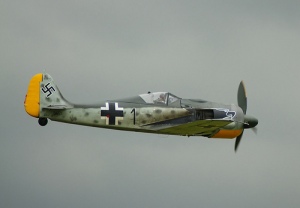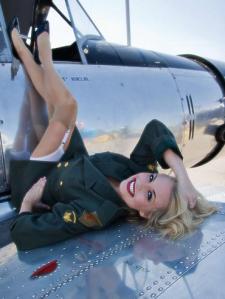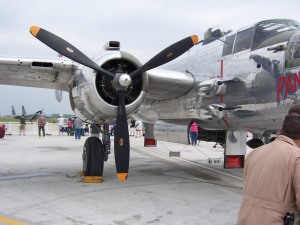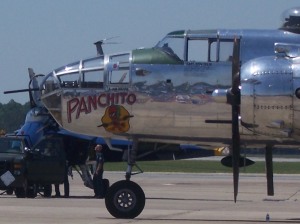 Fighter development slowed between World War I and II, with the most significant change coming late in the period, when the classic World War I type machines started to give way to metal monocoque or semi-monocoque monoplanes, with cantilever wing structures. Given limited defense budgets, air forces tended to be conservative in their aircraft purchases, and biplanes remained popular with pilots because of their agility. Designs such as the Gloster Gladiator, Fiat CR.42, and Polikarpov I-15 were common even in the late 1930s, and many were still in service as late as 1942. Up until the mid-1930s, the vast majority of fighter aircraft remained fabric-covered biplanes. Fighter armament eventually began to be mounted inside the wings, outside the arc of the propeller, though most designs retained two synchronized machine-guns above the engine (which were considered more accurate). Rifle-caliber guns were the norm, with .50 caliber machine guns and 20 mm cannons deemed “overkill.” Considering that many aircraft were constructed similarly to World War I designs (albeit with aluminum frames), it was not considered unreasonable to use World War I-style armament to counter them. There was insufficient aerial combat during most of the period to disprove this notion.
Fighter development slowed between World War I and II, with the most significant change coming late in the period, when the classic World War I type machines started to give way to metal monocoque or semi-monocoque monoplanes, with cantilever wing structures. Given limited defense budgets, air forces tended to be conservative in their aircraft purchases, and biplanes remained popular with pilots because of their agility. Designs such as the Gloster Gladiator, Fiat CR.42, and Polikarpov I-15 were common even in the late 1930s, and many were still in service as late as 1942. Up until the mid-1930s, the vast majority of fighter aircraft remained fabric-covered biplanes. Fighter armament eventually began to be mounted inside the wings, outside the arc of the propeller, though most designs retained two synchronized machine-guns above the engine (which were considered more accurate). Rifle-caliber guns were the norm, with .50 caliber machine guns and 20 mm cannons deemed “overkill.” Considering that many aircraft were constructed similarly to World War I designs (albeit with aluminum frames), it was not considered unreasonable to use World War I-style armament to counter them. There was insufficient aerial combat during most of the period to disprove this notion.
The rotary engine, popular during World War I, quickly disappeared, replaced chiefly by the stationary radial engine. Aircraft engines increased in power several-fold over the period, going from a typical 180 hp in the 1918 Fokker D.VII to 900 hp in the 1938 Curtiss P-36. The debate between the sleek in-line engines versus the more reliable radial models continued, with naval air forces preferring the radial engines, and land-based forces often choosing in-line units. Radial designs did not require a separate (and vulnerable) cooling system, but had increased drag. In-line engines often had a better power-to-weight ratio, but there were radial engines that kept working even after having suffered significant battle damage.
 Some air forces experimented with “heavy fighters” (called “destroyers” by the Germans). These were larger, usually a two- engine aircraft, sometimes adaptations of light or medium bomber types. Such designs typically had greater internal fuel capacity (thus longer range) and heavier armament than their single-engine counterparts. In combat, they proved ungainly and vulnerable to more nimble single-engine fighters.
Some air forces experimented with “heavy fighters” (called “destroyers” by the Germans). These were larger, usually a two- engine aircraft, sometimes adaptations of light or medium bomber types. Such designs typically had greater internal fuel capacity (thus longer range) and heavier armament than their single-engine counterparts. In combat, they proved ungainly and vulnerable to more nimble single-engine fighters.
The primary drive for fighter innovation, right up to the period of rapid rearmament in the late thirties, was not military budgets, but civilian aircraft races. Aircraft designed for these races pioneered innovations like streamlining and more powerful engines that would find their way into the fighters of World War II.
At the very end of the inter-war period came the Spanish Civil War. This was just the opportunity the German Luftwaffe, Italian Regia Aeronautica, and the Soviet Union’s Red Air Force needed to test their latest aircraft designs. Each party sent several aircraft to back their side in the conflict. In the dogfights over Spain, the latest Messerschmitt fighters (Bf 109) did well, as did the Soviet Polikarpov I-16. The German design, however, had considerable room for development and the lessons learned in Spain led to greatly improved models in World War II. The Russians, whose side lost in the conflict, nonetheless determined that their planes were sufficient for their immediate needs. I-16s were later slaughtered en masse by these improved German models in World War II, although they remained the most common Soviet front-line fighter until well into 1942. For their part, the Italians were satisfied with the performance of their Fiat CR.42 biplanes, and being short on funds, continued with this design even though it was obsolescent. The Spanish Civil War also provided an opportunity for updating fighter tactics. One of the innovations to result from the aerial warfare experience this conflict provided was the development of the “finger-four” formation by the German pilot Werner Mölders. Each fighter squadron (German: Staffel) was divided into several flights (Schwärme) of four aircraft. Each Schwarm was divided into two Rotten ,which was a pair of aircraft. Each Rotte was composed of a leader and a wingman. This flexible formation allowed the pilots to maintain greater situational awareness, and the two Rotte could split up at any time and attack on their own. The finger-four would become widely adopted as the fundamental tactical formation over the course of World War II.
 Aerial combat formed an important part of World War II military doctrine. The ability of aircraft to locate, harass, and interdict ground forces was an instrumental part of the German combined-arms doctrine, and their inability to achieve air superiority over Britain made a German invasion unfeasible. German Field Marshal Erwin Rommel noted the effect of airpower: “Anyone who has to fight, even with the most modern weapons, against an enemy in complete command of the air, fights like a savage against modern European troops, under the same handicaps and with the same chances of success.”
Aerial combat formed an important part of World War II military doctrine. The ability of aircraft to locate, harass, and interdict ground forces was an instrumental part of the German combined-arms doctrine, and their inability to achieve air superiority over Britain made a German invasion unfeasible. German Field Marshal Erwin Rommel noted the effect of airpower: “Anyone who has to fight, even with the most modern weapons, against an enemy in complete command of the air, fights like a savage against modern European troops, under the same handicaps and with the same chances of success.”
During the 1930s, two different streams of thought about air-to-air combat began to emerge, resulting in two different approaches to monoplane fighter development. In Japan and Italy especially, there continued to be a strong belief that lightly armed, highly maneuverable single-seat fighters would still play a primary role in air-to-air combat. Aircraft such as the Nakajima Ki-27, Nakajima Ki-43 and the Mitsubishi A6M Zero in Japan, and the Fiat G.50 and Macchi C.200 in Italy epitomized a generation of monoplanes designed to this concept.
The other stream of thought, which emerged primarily in Britain, Germany, the Soviet Union, and the United States was the belief that the high speeds of modern combat aircraft and the g-forces imposed by aerial combat meant that dogfighting in the classic World War I sense would be impossible. Fighters such as the Messerschmitt Bf 109, the Supermarine Spitfire, the Yakovlev Yak-1 and the Curtiss P-40 Warhawk were all designed for high level speeds and a good rate of climb. Good maneuverability was desirable, but it was not the primary objective.
The 1939 Soviet-Japanese Battle of Khalkhyn Gol and the initial German invasion of Poland that same year were too brief to provide much feedback to the participants for further evolution of their respective fighter doctrines. During the Winter War, the greatly outnumbered Finnish Air Force, which had adopted the German finger-four formation, bloodied the noses of Russia’s Red Air Force, which relied on the less effective tactic of a three-aircraft delta formation.
European theater (Western Front)
 The Battle of France, however, gave the Germans ample opportunity to prove they had mastered the lessons learned from their experiences in the Spanish Civil War. The Luftwaffe, with more combat-experience pilots and the battle-tested Messerschmitt Bf 109 fighter operating in the flexible finger-four formation, proved superior to its British and French contemporaries relying on the close, three-fighter “vic” (or “V”) and other formations, despite their flying fighters with comparable maneuver performance.
The Battle of France, however, gave the Germans ample opportunity to prove they had mastered the lessons learned from their experiences in the Spanish Civil War. The Luftwaffe, with more combat-experience pilots and the battle-tested Messerschmitt Bf 109 fighter operating in the flexible finger-four formation, proved superior to its British and French contemporaries relying on the close, three-fighter “vic” (or “V”) and other formations, despite their flying fighters with comparable maneuver performance.
The Battle of Britain was the first major military campaign to be fought entirely by air forces, and it offered further lessons for both sides. Foremost was the value of radar for detecting and tracking enemy aircraft formations, which allowed quick concentration of fighters to intercept them farther from their targets. As a defensive measure, this ground-controlled interception (GCI) approach allowed the Royal Air Force (RAF) to carefully marshal its limited fighter force for maximum effectiveness. At times, the RAF’s Fighter Command achieved interception rates greater than 80%.
In the summer of 1940, then Flight Lieutenant Adolph Malan introduced a variation of the German formation that he called the “fours in line astern”, which spread into more general use throughout Fighter Command. In 1941, Squadron Leader Douglas Bader adopted the “finger-four” formation itself, giving it its English-language name.
The Battle of Britain also revealed inadequacies of extant tactical fighters when used for long-range strategic attacks. The twin-engine heavy fighter concept was revealed as a failed concept as the Luftwaffe’s heavily armed but poorly maneuverable Messerschmitt Bf 110s proved highly vulnerable to nimble Hurricanes and Spitfires; the Bf 110s were subsequently relegated to night fighter and fighter-bomber roles for which they proved better-suited. Furthermore, the Luftwaffe’s Bf 109s, operating near the limits of their range, lacked endurance for prolonged dogfighting over Britain. When bomber losses induced Reichsmarschall Hermann Göring to assign most fighters to close-in escort duties, forcing them to fly and maneuver at reduced speeds, German fighter effectiveness fell and losses rose.
 The Allies themselves, however, would not learn this latter lesson until they sustained heavy bomber losses of their own during daylight raids against Germany. Despite the early assertions of strategic bombing advocates that “the bomber will always get through”, even heavily armed U.S. Army Air Force (USAAF) bombers like the Boeing B-17 Flying Fortress and Consolidated B-24 Liberator suffered such high losses to German fighters (such as the Focke-Wulf Fw 190 “bomber destroyer”) and flak (AAA) that – following the second raid on Schweinfurt in August 1943 – the U.S. Eighth Air Force was forced to suspend unescorted bombing missions into Germany until longer-range fighters became available for escort. These would appear in the form of Lockheed P-38 Lightnings, Republic P-47 Thunderbolts and North American P-51 Mustangs. The use of drop tanks also became common, which further made the heavy twin-engine fighter designs redundant, as single-engine fighters could now cover a similar distance. Extra fuel was carried in lightweight aluminum tanks below the aircraft, and the tanks were discarded when empty. Such innovations allowed American fighters to range over Germany and Japan by 1944.
The Allies themselves, however, would not learn this latter lesson until they sustained heavy bomber losses of their own during daylight raids against Germany. Despite the early assertions of strategic bombing advocates that “the bomber will always get through”, even heavily armed U.S. Army Air Force (USAAF) bombers like the Boeing B-17 Flying Fortress and Consolidated B-24 Liberator suffered such high losses to German fighters (such as the Focke-Wulf Fw 190 “bomber destroyer”) and flak (AAA) that – following the second raid on Schweinfurt in August 1943 – the U.S. Eighth Air Force was forced to suspend unescorted bombing missions into Germany until longer-range fighters became available for escort. These would appear in the form of Lockheed P-38 Lightnings, Republic P-47 Thunderbolts and North American P-51 Mustangs. The use of drop tanks also became common, which further made the heavy twin-engine fighter designs redundant, as single-engine fighters could now cover a similar distance. Extra fuel was carried in lightweight aluminum tanks below the aircraft, and the tanks were discarded when empty. Such innovations allowed American fighters to range over Germany and Japan by 1944.
As the war progressed, the growing numbers of these advanced, long-range fighters flown by pilots with increasing experience eventually overwhelmed their German opposition, despite the Luftwaffe’s introduction of technological innovations like jet- and rocket-powered interceptors. The steady attrition of experienced pilots forced the Germans to more frequently dip into their training pool to make up numbers when casualties surged. While new Allied airmen in Europe were well-trained, new Luftwaffe pilots were seldom able to get effective training – particularly by the summer of 1944, when Allied fighters often loitered around their airfields. Luftwaffe training flights were additionally hampered by the increasingly acute fuel shortages that began in April 1944.
European theater (Eastern Front)
On the Eastern Front, the strategic surprise of Operation Barbarossa demonstrated that Soviet air defense preparations were woefully inadequate, and the Great Purge rendered any lessons learned by the Red Air Force command from previous experience in Spain and Finland virtually useless. During the first few months of the invasion, Axis air forces were able to destroy large numbers of Red Air Force aircraft on the ground and in one-sided dogfights. However, by the winter of 1941–1942, the Red Air Force was able to put together a cohesive air defense of Moscow, successfully interdict attacks on Leningrad, and begin production of new aircraft types in the relocated semi-built factories in the Urals, Siberia, Central Asia and the Caucasus. These facilities produced more advanced monoplane fighters, such as the Yak-1, Yak-3, LaGG-3, and MiG-3, to wrest air superiority from the Luftwaffe. However, Soviet aircrew training was hasty in comparison to that provided to the Luftwaffe, so Soviet pilot losses continued to be disproportionate until a growing number of survivors were matched to more effective machines.
Beginning in 1942, significant numbers of British, and later U.S., fighter aircraft were also supplied to aid the Soviet war effort, with the Bell P-39 Airacobra proving particularly effective in the lower-altitude combat typical of the Eastern Front. Also from that time, the Eastern Front became the largest arena of fighter aircraft use in the world; fighters were used in all of the roles typical of the period, including close air support, interdiction, escort and interception roles. Some aircraft were armed with weapons as large as 45 mm cannon (particularly for attacking enemy armored vehicles), and the Germans began installing additional smaller cannons in under-wing pods to assist with ground-attack missions.
Pacific theatre
 In the Pacific Theater, the experienced Japanese used their latest Mitsubishi A6M “Zero” to clear the skies of all opposition. Allied air forces – often flying obsolete aircraft, as the Japanese were not deemed as dangerous as the Germans – were caught off-guard and driven back until the Japanese became overextended. While the Japanese entered the war with a cadre of superbly trained airmen, they were never able to adequately replace their losses with pilots of the same quality, resulting in zero leave for experienced pilots and sending pilots with minimal skill into battle, while the British Commonwealth Air Training Plan and U.S. schools produced thousands of competent airmen, compared to hundred the Japanese graduated a year before the war. Japanese fighter planes were also optimized for agility and range, and in time Allied airmen developed tactics that made better use of the superior armament and protection in their Grumman F4F Wildcats and Curtiss P-40s. From mid-1942, newer Allied fighter models were faster (Wildcat was 13 mph slower than the Zero, but the Warhawk was 29 mph faster) and better-armed than the Japanese fighters. Improved tactics such as the Thach weave helped counter the more agile Zeros and Nakajima Ki-43 ‘Oscars’. Japanese industry was not up to the task of mass-producing fighter designs equal to the latest Western models, and Japanese fighters had been largely driven from the skies by mid-1944.
In the Pacific Theater, the experienced Japanese used their latest Mitsubishi A6M “Zero” to clear the skies of all opposition. Allied air forces – often flying obsolete aircraft, as the Japanese were not deemed as dangerous as the Germans – were caught off-guard and driven back until the Japanese became overextended. While the Japanese entered the war with a cadre of superbly trained airmen, they were never able to adequately replace their losses with pilots of the same quality, resulting in zero leave for experienced pilots and sending pilots with minimal skill into battle, while the British Commonwealth Air Training Plan and U.S. schools produced thousands of competent airmen, compared to hundred the Japanese graduated a year before the war. Japanese fighter planes were also optimized for agility and range, and in time Allied airmen developed tactics that made better use of the superior armament and protection in their Grumman F4F Wildcats and Curtiss P-40s. From mid-1942, newer Allied fighter models were faster (Wildcat was 13 mph slower than the Zero, but the Warhawk was 29 mph faster) and better-armed than the Japanese fighters. Improved tactics such as the Thach weave helped counter the more agile Zeros and Nakajima Ki-43 ‘Oscars’. Japanese industry was not up to the task of mass-producing fighter designs equal to the latest Western models, and Japanese fighters had been largely driven from the skies by mid-1944.
Technological innovations
 Piston-engine power increased considerably during the war. The Curtiss P-36 Hawk had a 900 hp (670 kW) radial engine but was soon redesigned as the P-40 Warhawk with a 1100 hp (820 kW) in-line engine. By 1943, the latest P-40N had a 1300 hp (970 kW) Allison engine. At war’s end, the German Focke-Wulf Ta 152 interceptor could achieve 2050 hp (1530 kW) with an MW-50 (methanol-water injection) supercharger and the American P-51H Mustang fitted with the Packard V-1650-9 could achieve 2218 hp (1650 kW) under war emergency power. The Spitfire Mk I of 1939 was powered by a 1030 hp (770 kW) Merlin II; its 1945 successor, the Spitfire F.Mk 21, was equipped with the 2035 hp (1520 kW) Griffon 61. Likewise, the radial engines favored for many fighters also grew from 1,100 hp (820 kW) to as much as 2090 hp (770 kW) during the same timeframe.
Piston-engine power increased considerably during the war. The Curtiss P-36 Hawk had a 900 hp (670 kW) radial engine but was soon redesigned as the P-40 Warhawk with a 1100 hp (820 kW) in-line engine. By 1943, the latest P-40N had a 1300 hp (970 kW) Allison engine. At war’s end, the German Focke-Wulf Ta 152 interceptor could achieve 2050 hp (1530 kW) with an MW-50 (methanol-water injection) supercharger and the American P-51H Mustang fitted with the Packard V-1650-9 could achieve 2218 hp (1650 kW) under war emergency power. The Spitfire Mk I of 1939 was powered by a 1030 hp (770 kW) Merlin II; its 1945 successor, the Spitfire F.Mk 21, was equipped with the 2035 hp (1520 kW) Griffon 61. Likewise, the radial engines favored for many fighters also grew from 1,100 hp (820 kW) to as much as 2090 hp (770 kW) during the same timeframe.
The first turbojet-powered fighter designs became operational in 1944, and clearly outperformed their piston-engined counterparts. New designs such as the Messerschmitt Me 262 and Gloster Meteor demonstrated the effectiveness of the new propulsion system. (Rocket-powered interceptors – most notable the Messerschmitt Me 163 – appeared at the same time, but proved less effective.) Many of these fighters could do over 660 km/h in level flight, and were fast enough in a dive that they started encountering the transonic buffeting experienced near the speed of sound; such turbulence occasionally resulted in a jet breaking up in flight due to the heavy load placed on an aircraft near the so-called “sound barrier”. Dive brakes were added to jet fighters late in World War II to minimize these problems and restore control to pilots.
More powerful armament became a priority early in the war, once it became apparent that newer stressed-skin monoplane fighters could not be easily shot down with rifle-caliber machine guns. The Germans’ experiences in the Spanish Civil War led them to put 20 mm cannons on their fighters. The British soon followed suit, putting cannons in the wings of their Hurricanes and Spitfires. The Americans, lacking a native cannon design, instead chose to place multiple .50 caliber (12.7 mm) machine guns on their fighters. Armaments continued to increase over the course of the war, with the German Me 262 jet having four 30 mm cannons in the nose. Cannons fired explosive shells, and could blast a hole in an enemy aircraft rather than relying on kinetic energy from a solid bullet striking a critical subsystem (fuel line, hydraulics, control cable, pilot, etc.). A debate existed over the merits of high rate-of-fire machine guns versus slower-firing, but more devastating, cannon.
With the increasing need for close air support on the battlefield, fighters were increasingly fitted with bomb racks and used as fighter-bombers. Some designs, such as the German Fw 190, proved extremely capable in this role – though the designer Kurt Tank had designed it as a pure interceptor. While carrying air-to-surface ordnance such as bombs or rockets beneath the aircraft’s wing, its maneuverability is decreased because of lessened lift and increased drag, but once the ordnance is delivered (or jettisoned), the aircraft is again a fully capable fighter aircraft. By their flexible nature, fighter-bombers offer the command staff the freedom to assign a particular air group to air superiority or ground-attack missions, as need requires.
 Rapid technology advances in radar, which had been invented shortly prior to World War II, would permit their being fitted to some fighters, such as the Messerschmitt Bf 110, Bristol Beaufighter, de Havilland Mosquito, Grumman F6F Hellcat and Northrop P-61 Black Widow, to enable them to locate targets at night. The Germans developed several night-fighter types as they were under constant night bombardment by RAF Bomber Command. The British, who developed the first radar-equipped night fighters in 1940–1941, lost their technical lead to the Luftwaffe. Since the radar of the era was fairly primitive and difficult to use, larger two- or three-seat aircraft with dedicated radar operators were commonly adapted to this role.
Rapid technology advances in radar, which had been invented shortly prior to World War II, would permit their being fitted to some fighters, such as the Messerschmitt Bf 110, Bristol Beaufighter, de Havilland Mosquito, Grumman F6F Hellcat and Northrop P-61 Black Widow, to enable them to locate targets at night. The Germans developed several night-fighter types as they were under constant night bombardment by RAF Bomber Command. The British, who developed the first radar-equipped night fighters in 1940–1941, lost their technical lead to the Luftwaffe. Since the radar of the era was fairly primitive and difficult to use, larger two- or three-seat aircraft with dedicated radar operators were commonly adapted to this role.















